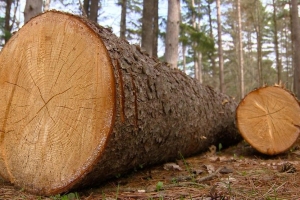
How Much Timber Does the U.S. Harvest, and How is it Used?By John Greene for Forest2Market  U.S. landowners manage their forests to maximize tree growth and their return on investment while at the same time providing wildlife habitat, protecting water quality, sequestering carbon and supporting a host of other environmental benefits.
U.S. landowners manage their forests to maximize tree growth and their return on investment while at the same time providing wildlife habitat, protecting water quality, sequestering carbon and supporting a host of other environmental benefits.
Sept. 1, 2020 - When it comes to the issue of managing America's forests, environmental and economic concerns can often seem incompatible. Those unfamiliar with forestry and silviculture practices oftentimes approach this subject believing that there is either one advantage or the other, but not both. This simply isn't true, and any claim that America's trees are used for anything less than their full potential is ill informed. Landowners manage their forests to maximize tree growth and their return on investment while at the same time providing wildlife habitat, protecting water quality, sequestering carbon and supporting a host of other environmental benefits. In turn, forest products companies use the trees that they buy from landowners to the fullest extent possible because it makes both financial and environmental sense. How do we know this ecological/economic relationship works? Per recent data from the US Forest Service's Forest Inventory and Analysis (FIA) Program, forest and woodland area in the United States has stabilized at 823 million acres following decades of expansion. Forest and woodlands now comprise over one-third of the US landscape and contain 1 trillion cubic feet of wood volume despite a booming population and ever-sprawling urban centers. Forest2Market's in-depth analysis of historical data over the past six decades documents the link between increased demand for forest products and increased forest inventory. Further, it explains that the dramatic increase in forest inventory was made possible by even more remarkable increases in forest productivity, especially on privately-owned timberlands. Where Does Harvested Timber Go?To get an idea of how harvested timber is routed throughout the forest supply chain, it's important to first recognize that the size, scale and economic impact of private, working forests on the US economy is tremendous. The total direct, indirect and induced employment effect associated with America's private timberlands in 2016 (the most recent year for which data is available from the Forest Inventory and Analysis National Program) was around 2.5 million jobs, $109.4 billion in annual payroll and $288 billion in sales and manufacturing. As such, the sustainable harvest and regeneration of trees is of the utmost importance for the US forest industry. In 2018 (the most recent year for which data is available from The Food and Agriculture Organization of the United Nations), nearly 439 million cubic meters (m3) of roundwood was harvested from American timberlands (both public and private) and used to manufacture a number of products that we have come to depend on in our daily lives including tissue and toilet paper, furniture and lumber, home and office utensils, biochemicals, and a host of other products. 
How are Harvested Trees Used?In the US South, pine trees are considered mature at 25-40 years old. Plantation stands of trees (acreages of trees that are continuously planted, harvested and replanted) are typically "thinned" when trees are 12-15 years old; thinnings remove only a portion of the stand's smaller trees to make more room for the more desirable trees to grow larger. When trees reach a diameter large enough to produce high-value wood products, a final harvest takes place. It's important to note that the sizes of the trees removed during thinnings and final harvests are quite different. In general, the size of pine trees fall into the following categories that are measured by diameter at breast height (DBH):
As logs get larger, the per-ton value of the trees typically (but not always) increases; quality sawtimber that has a DBH of 18" is generally more valuable than 12" sawtimber, for instance. The complete article can be found on Forest2Market’s blog. About Forest2Market, Inc.Forest2Market provides pricing data, supply chain expertise and strategic consulting services to participants in the global wood and fiber supply chain. The Forest2Market's unique databases contain more than 400 million rows of transaction data; they are the foundation for all analytics available in the firm's business intelligence platform, SilvaStat360, as well as client resource studies and consulting engagements. To learn more, visit www.forest2market.com. SOURCE: Forest2Market |